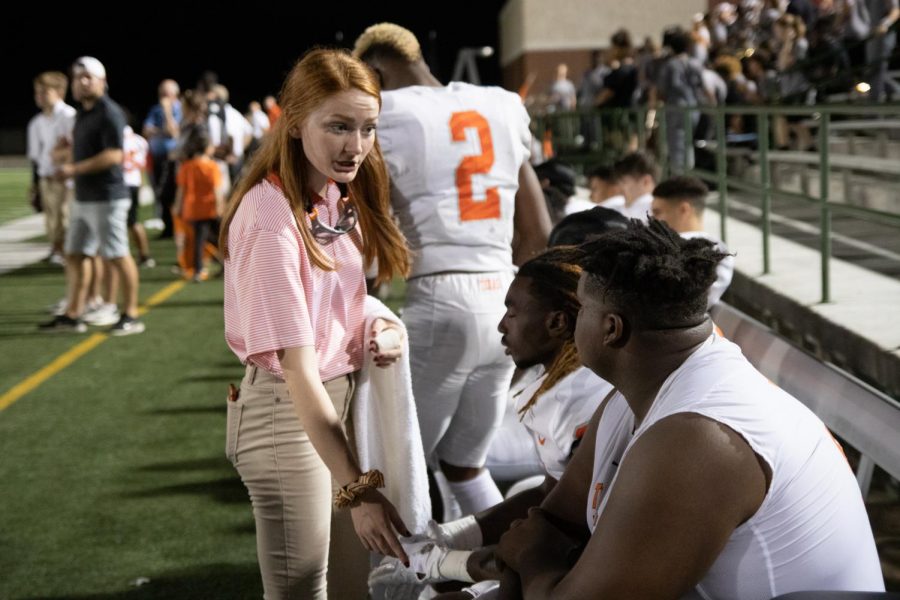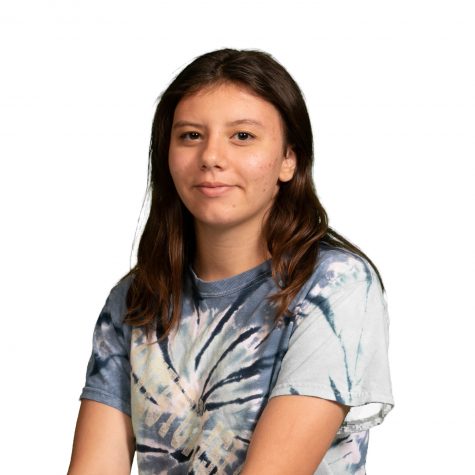Behind the scene team
Photo by Hollan Reed
Devun Saveall checks up on a previously injured player at a football game. The student trainers work very hard at sports events to maintain the safety of players.
October 31, 2019
On the sideline at every game. Waiting to give players water. The first ones on the field when a player gets hurt.
These people are our sports medicine students and athletic trainers.
Sports medicine is one of many beneficial classes for people who want a future in the medical field. Students that are apart of this program get firsthand experience with what to do when someone is hurt.
“Sometimes we help wrap, we do ice bags and whatever else to help out [our athletic trainers],” junior Chloe Pate said. “We get water bottles and go out [to football practice] and on a typical day, we’ll have a few injuries. When they can, the trainers will help us learn how to prevent [the injury].”
The athletic trainers, Forestt Bridges and Hannah Finch have impacted many students through the years that they have been working at Texas High.
“I joined sports medicine because of Forestt and Hannah,” sophomore Charity Gellington said. “I like the environment in the class itself and how they try to get to know us and we can talk to them like we’re friends.”
Sports medicine is very time consuming, Bridges and Finch spend their whole summer at the school and even work Saturdays.
“The worst part hands down is the hours, we average somewhere around 55 to 60 hours a week as a profession,” Bridges said. “[We] don’t get an off season. As soon as one sport is done you move on to the next.”
While Finch was in college she spent a lot of her time helping with the men’s basketball team at Stephen F. Austin University.
“I worked with the basketball team for a full season so I got to travel to away games and I worked every game,” Finch said. “I also traveled with them to the NCAA (National Collegiate Athletic Association) tournament in Dallas.”
Sports medicine students spend the last two to three weeks of summer at the school for football practices and come in the mornings and after school almost every weekday.
“The hardest part about being in sports medicine is being [at football practice or games] everyday,” Gellington said. “I have homework and other activities, and we’re usually out here for a long time
The most complaints from sports medicine students is that there is a lack of understanding and a lot of disrespect while they are on the field.
“Sometimes people are disrespectful and don’t appreciate what we do,” sophomore Emili Rios said. “They complain about the water being warm, but that’s because it’s so hot out here.”
Working in sports medicine can lead to meeting many professional and college athletes and getting access to areas where the public cannot go.
“I’ve been able to go to cool places, I’ve met and saved professional athletes that are at the top of their game. I have gone to stadiums and venues that I never dreamed that I would be in,” Bridges said. “We actually went to the Rangers stadium this summer and we went through out the whole stadium. We also went into the Houston Rockets locker room in the Toyota Center.
For Bridges, one of the most pleasing parts of being an athletic trainer is helping athletes get better so they can succeed.
“The best part of my profession is when I have taken someone from whatever status they are, which is usually physically [unable to perform], and get them to the point where they perform at one hundred percent,” Bridges said. “To see that person go at one hundred percent is what I’m in [sports medicine] for.”
















